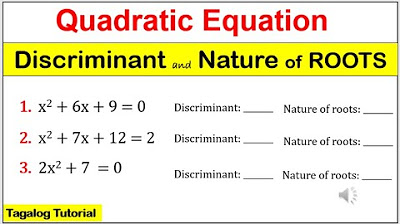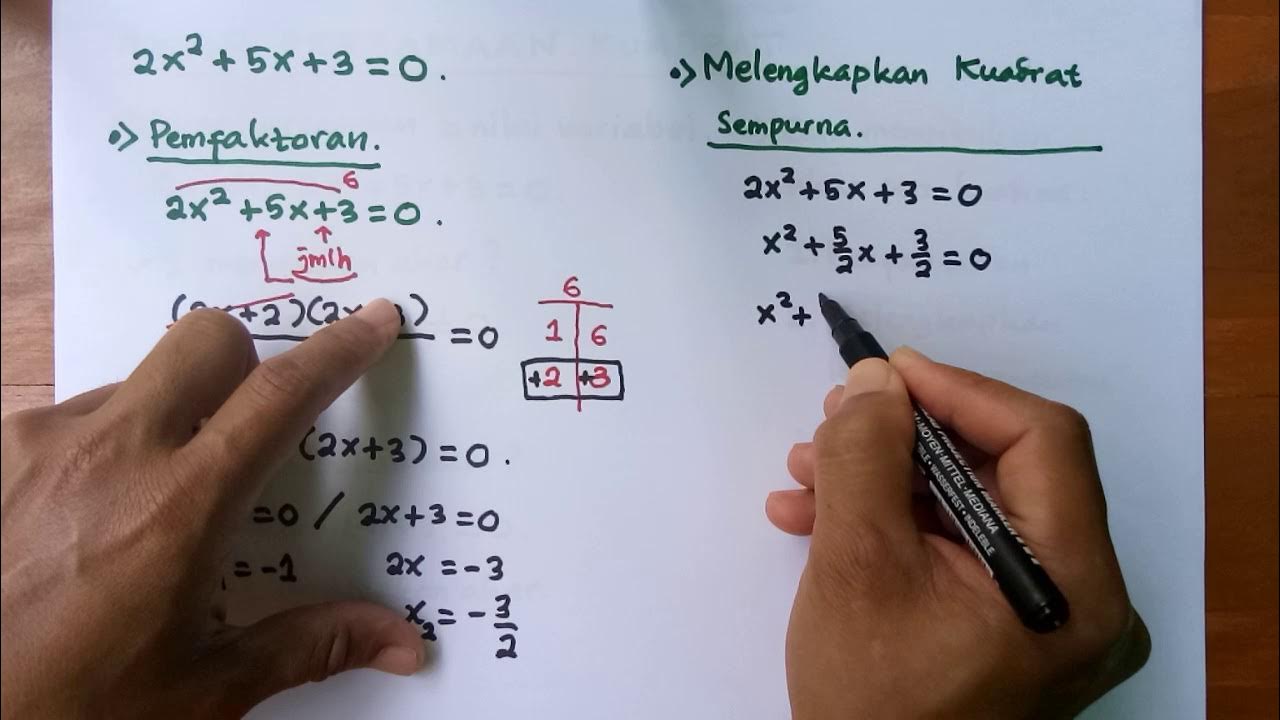Nature of Roots - Examples | Quadratic Equations | Don't Memorise
Summary
TLDRThis educational video script explains how to determine the nature of roots of a quadratic equation. It emphasizes the importance of the discriminant, b^2 - 4ac, in identifying whether roots are real and distinct, equal, or non-existent. The script guides through examples, showing how a discriminant of zero indicates equal real roots, a positive value suggests two distinct real roots, and a negative value means no real roots. It encourages viewers to solve and verify the nature of roots for three given quadratic equations.
Takeaways
- 📚 The nature of roots of a quadratic equation is determined by the discriminant, which is calculated as b^2 - 4ac.
- 🔍 If the discriminant is greater than zero, the equation has two distinct real roots.
- 🔄 If the discriminant equals zero, the equation has two equal real roots.
- 🚫 If the discriminant is less than zero, the equation has no real roots.
- 🧩 The first quadratic equation provided has a = 9, b = -12, and the discriminant is zero, indicating equal real roots.
- 🔢 For the first equation, the calculation of the discriminant is shown as (-12)^2 - 4 * 9 * 4 = 144 - 144 = 0.
- 📝 The second equation has a = 2, b = -9, and a positive discriminant, indicating two distinct real roots.
- 📉 The third equation's discriminant is negative, which means it has no real roots.
- 📚 The script encourages practice by solving the equations to verify the nature of the roots.
- 👨🏫 The explanation is instructional, guiding the learner through the process of determining the nature of roots for quadratic equations.
- 🎶 The script ends with a musical note, suggesting a conclusion or transition in the presentation.
Q & A
What is the general form of a quadratic equation?
-The general form of a quadratic equation is \( ax^2 + bx + c = 0 \), where \( a \), \( b \), and \( c \) are constants and \( a \neq 0 \).
What is the significance of the discriminant in a quadratic equation?
-The discriminant, denoted as \( \Delta = b^2 - 4ac \), determines the nature of the roots of a quadratic equation. If \( \Delta > 0 \), the equation has two distinct real roots; if \( \Delta = 0 \), it has two equal real roots; and if \( \Delta < 0 \), it has no real roots.
How do you calculate the discriminant for the quadratic equation \( 9x^2 - 12x + 4 = 0 \)?
-For the equation \( 9x^2 - 12x + 4 = 0 \), the discriminant is calculated as \( \Delta = (-12)^2 - 4 \times 9 \times 4 = 144 - 144 = 0 \).
What does a discriminant of zero indicate for the quadratic equation \( 9x^2 - 12x + 4 = 0 \)?
-A discriminant of zero indicates that the quadratic equation \( 9x^2 - 12x + 4 = 0 \) has two equal real roots.
What are the values of \( a \), \( b \), and \( c \) for the quadratic equation \( 2x^2 - 9x + 4 = 0 \)?
-For the equation \( 2x^2 - 9x + 4 = 0 \), the values are \( a = 2 \), \( b = -9 \), and \( c = 4 \).
How do you determine the nature of the roots for the quadratic equation \( 2x^2 - 9x + 4 = 0 \)?
-For the equation \( 2x^2 - 9x + 4 = 0 \), the discriminant is \( \Delta = (-9)^2 - 4 \times 2 \times 4 = 49 \). Since \( \Delta > 0 \), the equation has two distinct real roots.
What is the discriminant for the quadratic equation \( x^2 + 9x + 7 = 0 \)?
-For the equation \( x^2 + 9x + 7 = 0 \), the discriminant is \( \Delta = 9^2 - 4 \times 1 \times 7 = 81 - 28 = 53 \).
What does a positive discriminant signify for the roots of a quadratic equation?
-A positive discriminant signifies that the quadratic equation has two distinct real roots.
What are the steps to find the nature of the roots of a quadratic equation?
-The steps are: (1) Write down the quadratic equation in the form \( ax^2 + bx + c = 0 \), (2) Identify the values of \( a \), \( b \), and \( c \), (3) Calculate the discriminant \( \Delta = b^2 - 4ac \), and (4) Determine the nature of the roots based on the value of \( \Delta \).
Can a quadratic equation have complex roots?
-Yes, a quadratic equation can have complex roots if the discriminant is negative, as complex roots are not real numbers.
How can you verify the roots of a quadratic equation?
-You can verify the roots by substituting them back into the original equation and checking if both sides of the equation balance.
Outlines

This section is available to paid users only. Please upgrade to access this part.
Upgrade NowMindmap

This section is available to paid users only. Please upgrade to access this part.
Upgrade NowKeywords

This section is available to paid users only. Please upgrade to access this part.
Upgrade NowHighlights

This section is available to paid users only. Please upgrade to access this part.
Upgrade NowTranscripts

This section is available to paid users only. Please upgrade to access this part.
Upgrade NowBrowse More Related Video

Jenis-jenis akar persamaan kuadrat || akar real berbeda, akar real sama, akar tidal real (IMAJINER)

Polinomial (Bagian 5) - Cara Menentukan Akar-akar Persamaan Polinomial

THE NATURE OF THE ROOTS OF A QUADRATIC EQUATION USING THE DISCRIMINANT || GRADE 9 MATHEMATICS Q1

Persamaan Kuadrat [Part 5] - Menyusun Persamaan Kuadrat Baru

MATH9 DISCRIMINANT and NATURE OF ROOTS of quadratic equation #math9 #discriminant #natureofroots

Mudah Dipahami 3 CARA MENENTUKAN AKAR PERSAMAAN KUADRAT
5.0 / 5 (0 votes)